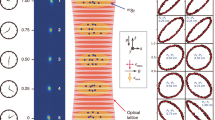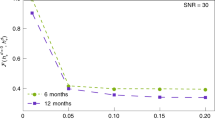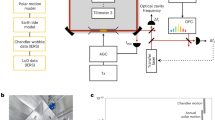Abstract
The Newtonian gravitational constant, G, is one of the most fundamental constants of nature, but we still do not have an accurate value for it. Despite two centuries of experimental effort, the value of G remains the least precisely known of the fundamental constants. A discrepancy of up to 0.05 per cent in recent determinations of G suggests that there may be undiscovered systematic errors in the various existing methods. One way to resolve this issue is to measure G using a number of methods that are unlikely to involve the same systematic effects. Here we report two independent determinations of G using torsion pendulum experiments with the time-of-swing method and the angular-acceleration-feedback method. We obtain G values of 6.674184 × 10−11 and 6.674484 × 10−11 cubic metres per kilogram per second squared, with relative standard uncertainties of 11.64 and 11.61 parts per million, respectively. These values have the smallest uncertainties reported until now, and both agree with the latest recommended value within two standard deviations.
This is a preview of subscription content, access via your institution
Access options
Access Nature and 54 other Nature Portfolio journals
Get Nature+, our best-value online-access subscription
$29.99 / 30 days
cancel any time
Subscribe to this journal
Receive 51 print issues and online access
$199.00 per year
only $3.90 per issue
Buy this article
- Purchase on Springer Link
- Instant access to full article PDF
Prices may be subject to local taxes which are calculated during checkout



Similar content being viewed by others
References
Cavendish, H. Experiments to determine the density of the Earth. Phil. Trans. R. Soc. B 88, 469–526 (1798).
Gillies, G. T. The Newtonian gravitational constant: an index of measurements. Metrologia 24, 1–56 (1987).
Rothleitner, C. & Schlamminger, S. Measurements of the Newtonian constant of gravitation, G. Rev. Sci. Instrum. 88, 111101 (2017).
Mohr, P. J., Newell, D. B. & Taylor, B. N. CODATA recommended values of the fundamental physical constants: 2014. Rev. Mod. Phys. 88, 035009 (2016).
Quinn, T. Measuring big G. Nature 408, 919–921 (2000).
Quinn, T. Don’t stop the quest to measure Big G. Nature 505, 455 (2014).
Schlamminger, S. Fundamental constants: a cool way to measure big G. Nature 510, 478–480 (2014).
Gibney, E. Rivals join forces to nail down Big G. Nature 514, 150–151 (2014).
Quinn, T. J., Speake, C. C., Richman, S. J., Davis, R. S. & Picard, A. A new determination of G using two methods. Phys. Rev. Lett. 87, 111101 (2001).
Quinn, T. J., Parks, H. V., Speake, C. C. & Davis, R. S. Improved determination of G using two methods. Phys. Rev. Lett. 111, 101102 (2013).
Quinn, T., Speake, C., Parks, H. & Davis, R. The BIPM measurements of the Newtonian constant of gravitation, G. Phil. Trans. R. Soc. A 372, 20140032 (2014).
Heyl, P. R. A redetermination of the constant of gravitation. J. Res. Natl. Bur. Stand. 5, 1243–1290 (1930).
Heyl, P. R. & Chrzanowski, P. A new determination of the constant of gravitation. J. Res. Natl. Bur. Stand. 29, 1–31 (1942).
Rose, R. D., Parker, H. M., Lowry, R. A., Kuhlthau, A. R. & Beams, J. W. Determination of the gravitational constant G. Phys. Rev. Lett. 23, 655–658 (1969).
Gundlach, J. H. & Merkowitz, S. M. Measurement of Newton’s constant using a torsion balance with angular acceleration feedback. Phys. Rev. Lett. 85, 2869–2872 (2000).
Luo, J., Hu, Z. K., Fu, X. H., Fan, S. H. & Tang, M. X. Determination of the Newtonian gravitational constant G with a nonlinear fitting method. Phys. Rev. D 59, 042001 (1998).
Hu, Z. K., Guo, J. Q. & Luo, J. Correction of source mass effects in the HUST-99 measurement of G. Phys. Rev. D 71, 127505 (2005).
Luo, J. et al. Determination of the Newtonian gravitational constant G with time-of-swing method. Phys. Rev. Lett. 102, 240801 (2009).
Tu, L. C. et al. New determination of the gravitational constant G with time-of-swing method. Phys. Rev. D 82, 022001 (2010).
Li, Q. et al. G measurements with time-of-swing method at HUST. Phil. Trans. R. Soc. A 372, 20140141 (2014).
Kuroda, K. Does the time-of-swing method give a correct value of the Newtonian gravitational constant? Phys. Rev. Lett. 75, 2796–2798 (1995).
Newman, R. D. & Bantel, M. K. On determining G using a cryogenic torsion pendulum. Meas. Sci. Technol. 10, 445–453 (1999).
Yang, S. Q. et al. Direct measurement of the anelasticity of a tungsten fiber. Phys. Rev. D 80, 122005 (2009).
Xue, C. et al. Preliminary determination of Newtonian gravitational constant with angular acceleration feedback method. Phil. Trans. R. Soc. A 372, 20140031 (2014).
Quan, L. D. et al. Feedback control of torsion balance in measurement of gravitational constant G with angular acceleration method. Rev. Sci. Instrum. 85, 014501 (2014).
Fan, X. D. et al. Coupled modes of the torsion pendulum. Phys. Lett. A 372, 547–552 (2008).
Numata, K., Horowitz, J. & Camp, J. Coated fused silica fibers for enhanced sensitivity torsion pendulum for LISA. Phys. Lett. A 370, 91–98 (2007).
Li, Q. et al. Research on supporting mounts of spheres in measurement of gravitational constant G. Rev. Sci. Instrum. 87, 034504 (2016).
Luo, J., Wang, W. M., Hu, Z. K. & Wang, X. L. Precise determination of separation between spherical attracting masses in measuring the gravitational constant. Chin. Phys. Lett. 18, 1012–1014 (2001).
Liu, L. X. et al. Measurement of density inhomogeneity for glass pendulum. Chin. Phys. Lett. 25, 4203–4206 (2008).
Liu, L. X., Shao, C. G., Tu, L. C. & Luo, J. Measurement of density inhomogeneity for source masses in time-of-swing method of measuring G. Chin. Phys. Lett. 26, 010403 (2009).
Guo, J. Q., Hu, Z. K., Gu, B. M. & Luo, J. Measurement of eccentricity of the centre of mass from the geometric centre of a sphere. Chin. Phys. Lett. 21, 612–615 (2004).
Liu, L. X. et al. Precision measurement of distribution of film thickness on pendulum for experiment of G. Chin. Phys. Lett. 26, 090402 (2009).
Zener, C. Elasticity and Anelasticity of Metals (University of Chicago Press, Chicago, 1948).
Luo, J., Hu, Z. K. & Hsu, H. Thermoelastic property of the torsion fiber in the gravitational experiments. Rev. Sci. Instrum. 71, 1524–1528 (2000).
Hu, Z. K., Wang, X. L. & Luo, J. Thermoelastic correction in the torsion pendulum experiment. Chin. Phys. Lett. 18, 7–9 (2001).
Li, Q., Liu, L. X., Tu, L. C., Shao, C. G. & Luo, J. Effect of local magnetic field in G measurement with time-of-swing method. Chin. Phys. Lett. 27, 070401 (2010).
Tian, Y. L., Tu, Y. & Shao, C. G. Correlation method in period measurement of a torsion pendulum. Rev. Sci. Instrum. 75, 1971–1974 (2004).
Luther, G. G. & Towler, W. R. Redetermination of the Newtonian gravitational constant G. Phys. Rev. Lett. 48, 121–123 (1982).
Karagioz, O. & Izmailov, V. Measurement of the gravitational constant with a torsion balance. Meas. Tech. 39, 979–987 (1996).
Bagley, C. H. & Luther, G. G. Preliminary results of a determination of the Newtonian constant of gravitation: a test of the Kuroda hypothesis. Phys. Rev. Lett. 78, 3047–3050 (1997).
Kleinevoss, U. Bestimmung der Newtonschen Gravitationskonstanten G. PhD thesis (Univ. Wuppertal, 2002); http://elpub.bib.uni-wuppertal.de/servlets/DocumentServlet?id=335&lang=en.
Armstrong, T. R. & Fitzgerald, M. P. New measurements of G using the measurement standards laboratory torsion balance. Phys. Rev. Lett. 91, 201101 (2003).
Schlamminger, S. et al. Measurement of Newton’s gravitational constant. Phys. Rev. D 74, 082001 (2006).
Parks, H. V. & Faller, J. E. Simple pendulum determination of the gravitational constant. Phys. Rev. Lett. 105, 110801 (2010).
Newman, R., Bantel, M., Berg, E. & Cross, W. A measurement of G with a cryogenic torsion pendulum. Phil. Trans. R. Soc. A 372, 20140025 (2014).
Rosi, G., Sorrentino, F., Cacciapuoti, L., Prevedelli, M. & Tino, G. M. Precision measurement of the Newtonian gravitational constant using cold atoms. Nature 510, 518–521 (2014).
Acknowledgements
We are grateful to R. Newman, T. Quinn, C. Speake, J. E. Faller, J. H. Gundlach, H. J. Paik, Z. H. Lu, J. Luo and S. H. Fan for discussions and suggestions. We thank Q. T. Fan, Y. T. Zhang, B. P. Wang, X. D. Fan, M. Ke, L. Zhao, Y. Tu, J. Q. Guo, D. C. Chen, W. M. Wang, X. L. Wang, X. J. Luo, X. H. Fu, J. Tang and Y. B. Cheng for their early works on G measurement. We thank the National Institute of Metrology (NIM) of China for the calibration of some measuring instruments, source masses and the length gauges. This work is partly supported by the National Natural Science Foundation of China under grants number 91536223, 11722542, 11325523 and 11605295, the National Basic Research Program of China under grant number 2010CB832801 and the National Precise Gravity Measurement Facility.
Reviewer information
Nature thanks S. Schlamminger and the other anonymous reviewer(s) for their contribution to the peer review of this work.
Author information
Authors and Affiliations
Contributions
J.L. had the idea for the experiment. J.L. and S.-Q.Y. supervised all the experiments. Q.Li and J.-P.L. performed the experiment with the TOS method and analysed the data. C.X. and J.-F.W. performed the experiment with the AAF method and analysed the data. L.-D.Q. designed and built the feedback control system of the two turntables in the AAF method. C.-G.S. analysed all the errors and data independently. W.-H.T., H.X., L.-C.T., Q.Liu, L.-X.L., Q.-L.W., Z.-K.H., Z.-B.Z., P.-S.L., S.-C.W. and V.M. contributed to the analysis and discussion. S.-Q.Y., Q.Li and C.X. wrote the manuscript.
Corresponding authors
Ethics declarations
Competing interests
The authors declare no competing interests.
Additional information
Publisher’s note: Springer Nature remains neutral with regard to jurisdictional claims in published maps and institutional affiliations.
Extended data figures and tables
Extended Data Fig. 1 Photographs of the experimental apparatus.
a, Apparatus 1, used in TOS-I. b, Apparatus 2, used in TOS-II. c, The suspended pendulum and source masses in the vacuum chamber used in the TOS method. The copper tube around the fibre is used to reduce the temperature gradient. The electrostatic shield (here elevated to show the pendulum), the three-point mounts, the ULE-glass disk and the turntable are also shown. d, The preliminary apparatus used to perform the proof-of-principle measurements24,25 of G using the AAF method. e, The improved apparatus used in the present work. The apparatus was completely rebuilt to reduce several sources of uncertainty encountered in the proof-of-principle experiments (see text for details). f, The suspended pendulum and the optical path system used in the AAF method.
Extended Data Fig. 2 Fabrication of the silica fibre and measurement of its Q factor.
a, Photograph of a silica fibre pulled from a rod over an oxygen–natural gas flame. b, Magnetron sputtering equipment used for the coating of the silica fibres. c, The Bi target, with a height of ∼1 m. The Ge target (not shown here) is similar. The two targets are installed on opposite sides of the coating equipment, with the fibre located between the two targets and rotated continuously. The surfaces of the fibres were coated with a 5-nm-thick Ge layer and then a 10-nm-thick Bi layer. d, Typical decay curves of the torsional amplitude of a pendulum suspended by a ∼45-μm-diameter fibre. Curve A represents the uncoated silica fibre, with a Q factor of 2.6 × 105. Curve B corresponds to the coated silica fibre, with a Q factor of 5.5 × 104. The dot-dashed lines denote fitting curves of the exponential function A = A0exp(−πf0t/Q), where A0 is the initial amplitude, f0 is the free oscillation frequency and t is the time.
Extended Data Fig. 3 Schematic diagram of the source masses.
a, b, In the TOS method, spheres 1 and 3 are used in apparatus 1 (TOS-I; a) and spheres 2 and 4 are used in apparatus 2 (TOS-II; b). S1,3 and S2,4 are the horizontal distances of the geometric centres of the spheres in apparatus 1 and 2, respectively. c, In the AAF method, spheres 7, 9, 10 and 12 are used. S7,9 and S10,12 are the horizontal distances and S7,10 and S9,12 are the vertical distances between the geometric centres of the spheres.
Extended Data Fig. 4 Effect of temperature on the measurement of the angular acceleration in the AAF method.
A modulation experiment was carried out by increasing the temperature variation in the room to about 1 °C. Solid circles represent the average angular acceleration of the pendulum turntable over 12-h data taking periods. The dashed line with a slope of (2.2 ± 3.6) × 10−12 rad s−2 °C−1 represents the least-squares fitting curve. The result indicates that the apparatus is insensitive to the temperature variation and that a temperature variation of less than 0.1 °C during each experimental run contributes an uncertainty of less than 0.91 p.p.m. to the G measurement.
Extended Data Fig. 5 Electrostatic effect on the measurement of the pendulum period in the TOS method.
Different voltages are applied on the shield in the sequence: ground, 0.1 V, −0.1 V, ground. For each voltage, 4–5 sets of measurements of the pendulum period are performed at the ‘near’ and ‘far’ configurations. The corresponding change of the frequency squared (Δω2) for the steps of the sequence is determined to be 1.662192(8) × 10−6 s−2, 1.662184(16) × 10−6 s−2, 1.662181(15) × 10−6 s−2 and 1.662200(13) × 10−6 s−2, respectively. The results show that the period changes with the applied voltage, but the Δω2 values for the ‘near’ and ‘far’ configurations are consistent with each other within the statistical uncertainty. The dot-dashed lines are polynomial fitting curves that represent the period drift due to the ‘aging’ effect of the fibre.
Supplementary information
Supplementary Information
This file contains the Supplementary Discussion sections about the experimental method, the alignment and positioning, the nonlinear effects in the ToS method, the data acquisition and correction factors, compensation of the background gravitational gradient in the AAF method, the combination of the values of G, and discussion of the results. The file also contains Supplementary Figure 1 showing the PSD of the pendulum twist angle in AAF-I and the photo of the ULE shelf, Supplementary Figure 2 showing the photo of the lead blocks used to compensate the lab-fixed background gradient field, Supplementary Table 1 showing the parameters of the two-stage pendulum system, Supplementary Table 2 showing the determined ΔCg/I and the average value of <Δω2> in the ToS method, Supplementary Table 3 showing the determined Pg,l,m and the average value of <αt> in the AAF method, and Supplementary Table 4, showing the nonlinearity effects of the gravitational field and the fiber in the ToS method.
Supplementary Data
This file contains the source data for Supplementary Figure 1.
Rights and permissions
About this article
Cite this article
Li, Q., Xue, C., Liu, JP. et al. Measurements of the gravitational constant using two independent methods. Nature 560, 582–588 (2018). https://doi.org/10.1038/s41586-018-0431-5
Received:
Accepted:
Published:
Issue Date:
DOI: https://doi.org/10.1038/s41586-018-0431-5
Keywords
This article is cited by
-
Scalable all-optical cold damping of levitated nanoparticles
Nature Nanotechnology (2023)
-
Observation and research of deep underground multi-physical fields—Huainan −848 m deep experiment
Science China Earth Sciences (2023)
-
Dynamic measurement of gravitational coupling between resonating beams in the hertz regime
Nature Physics (2022)
-
Good vibrations
Nature Physics (2022)
-
Resolving the Singularity by Looking at the Dot and Demonstrating the Undecidability of the Continuum Hypothesis
Foundations of Science (2022)
Comments
By submitting a comment you agree to abide by our Terms and Community Guidelines. If you find something abusive or that does not comply with our terms or guidelines please flag it as inappropriate.



